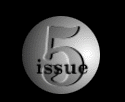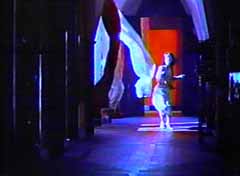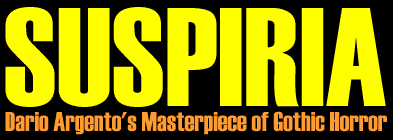When Suzy finally arrives at the school--a triumph of set design in itself--she is immediately confronted by a mystery. A young woman, highly agitated, stands outside the front door in the pouring rain. She is arguing with someone inside, but Suzy hears only snatches of their conversation before the woman runs off into the woods. Suzy is the last person to see her alive, but she will remember the words she heard (a clue involving a secret passage) when the need arises. Other than this poor victim and one other girl who meets a similarly ghastly fate, Argento presents the other residents of the school as Grimm Brothers grotesques. Her fellow students are gossiping shrews, the senior instructress (Alida Valli) is a grinning harridan, and the headmistress (Joan Bennett) is officiously sinister. Argento even throws in a hunchbacked mute servant with false teeth and a cleaver-wielding Russian scullery maid.
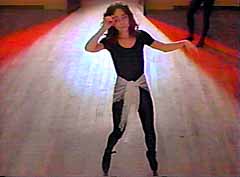
Suzy swoons.
All of Suzy's interactions with the staff and students contain varying degrees of menace, a point made clear when she suffers a nosebleed on her first day of dance practice. Her teacher had pushed Suzy to perform a rigorous ballet routine after she had been out of practice, and the strain caused a mild internal hemorrhage. Argento films her tortured swoon in a manner that has been compared to that of a dying swan, but it could also be seen as a child metaphorically falling into sleep. Indeed, she is only falling deeper into the nightmare. Suzy is trapped in a fairy-tale, and the secret which the school holds is that its female instructors are really a coven of witches, ruled by the ancient and horrible directress of the school, Elaina Marcos/Mater Suspiriorum.
The rest of the film strikes a discordant but effective balance between dreamy lyricism and flamboyant shock. On the one hand, Suzy's point of view is presented in hazy blues and soft pinkish-reds, and when she walks she often seems to be floating. The wine which Suzy is given to "restore her blood" following the ballet injury is drugged, but there can be no doubt that she is in some deeper sort of narcotic state (could she actually be asleep?) as she investigates the school. On the other hand, the rest of the characters are presented in stark, harsh colored lights with screaming synthesizers as they either scheme amongst themselves or meet violent, brutal deaths. On the night of Suzy's arrival, a fellow student is chased by a demonic killer who stabs her repeatedly in the chest, finally hacking his knife into her exposed, still-beating heart. He then ties his victim with rope and places her on top of the glass ceiling over the school's entrance hall. The ceiling collapses under her weight, leaving her hanging by her neck while a section of the ceiling's metal frame falls and bisects another student standing below. There is also a rain of maggots, a bat attack, and a woman who flees a pursuing maniac only to land in a room filled with razor-wire.
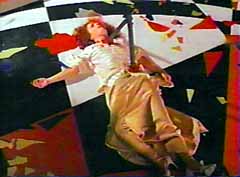
The grisly death of a student.
The contrasting styles of ethereal dream and stark shock suggest the difference between perception and reality, a theme which recurs often in Argento's films. The childlike Suzy may be seeing these horrible events as a fantasy, or a dream, but to the victims and to the evil coven behind the murders it is all terribly real. While that dichotomy fits into the film's idea that magic is everywhere, whether enchanting or sinister, there may be a more personal reason for such an approach. Argento has claimed that there is a piece of him in every film he makes, and most critics point to Tenebrae (1982) and Opera (1987) as the director's most self-revealing interpretations of the ways in which his ultra-violent work is perceived by the public. It could be argued that Suspiria is even more telling in this regard, as Suzy's character is clearly an Argento proxy, viewing death and horror with the same childlike fascination as he shows in nearly every public interview. The audience, conversely, is shown the "truth"--bloody, loud and agonizing--while Suzy never seems to be very horrified at what goes on around her, even taking the sedatives into account. Instead, she takes it all in visually (the wide-eyed Harper is a perfect bit of casting), and while we can sense her apprehension, her curiosity comes through much stronger than any anxiety or fear. At times, Suzy is Alice in Wonderland, and her thrill at discovering a secret enchanted world is not lessened by the fact that this particular Queen of Hearts is a centuries-old murderous witch. Similarly, the director's joy at the filmmaking process is undiminished by the fact that what he often stages is the cinematic equivalent of a tarted up three-ring abattoir. Thus, while it may be more circumspect in its tactics than Argento's later films, Suspiria is no less an essay on Argento's own voyeurism and its relationship to conventional views of filmed violence.
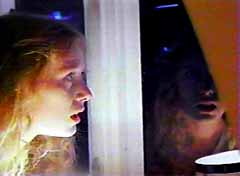
Don't go near the windows!
It naturally follows that Argento's true strength as a filmmaker is his direction of murder scenes, and the occult deaths presented here are among the bloodiest and hardest to take in horror history. Apart from the initial double-murder, the most flamboyant sequence involves a blind man who is trapped in a large public square with his seeing-eye dog after a night of drinking. Argento uses sound and well-placed establishing shots to convey a sense of utter helplessness and agoraphobic dread in the empty plaza, then swoops a specially-built camera from the roof of a building, down and past the terrified man. In a brilliant bit of misdirection, his death comes not from above but from below, as his trusted dog turns on its master and tears out his throat in panic.
But the showy murders are often lauded at the expense of the film's very real beauty. Suzy's discovery of the academy's covert purpose--the sustenance of an ancient witch--is handled in such a way as to be half-seen through the veil of sleep and the unconscious. Twinkling lights, hazy walks down long glittering corridors and the ever-present whispering are offset by sudden bursts of sound and color, revealing occult secrets both dark and magical. Perhaps no other film has presented the fairy-tale world of the supernatural with such a balanced mixture of childlike wonder and adult horror, save perhaps for Neal Jordan's interesting but flawed A Company of Wolves (1985). As local professor Udo Kier explains, there is magic all around us, both beautiful and terrible. In this startling motion picture, Argento makes that magic real. A masterpiece.
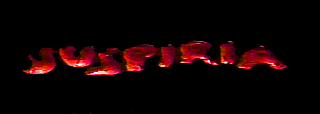
Robert Firsching is the founder of the genre film review Web site "AWCM: The Amazing World of Cult Movies." He lives in Northern
Virginia with his wife Anita and is currently working on a book about genre cinema in the video age.
Italian Horror Menu page
Italian Horror: A Brief Introduction
Mario Bava: The Illusion of Reality
Mario Bava's Rabid Dogs
Mario Bava Biography
The Horrible Dr. Hichcock
The Devil's Commandment 
Castle of Blood 
Nightmare Castle
The Bloody Pit of Horror 
Italian Horror in the Seventies
Suspiria
Italian Horror Web Links
© 1997 Robert Firsching
Photo credits: Hollywood Home Entertainment
|
